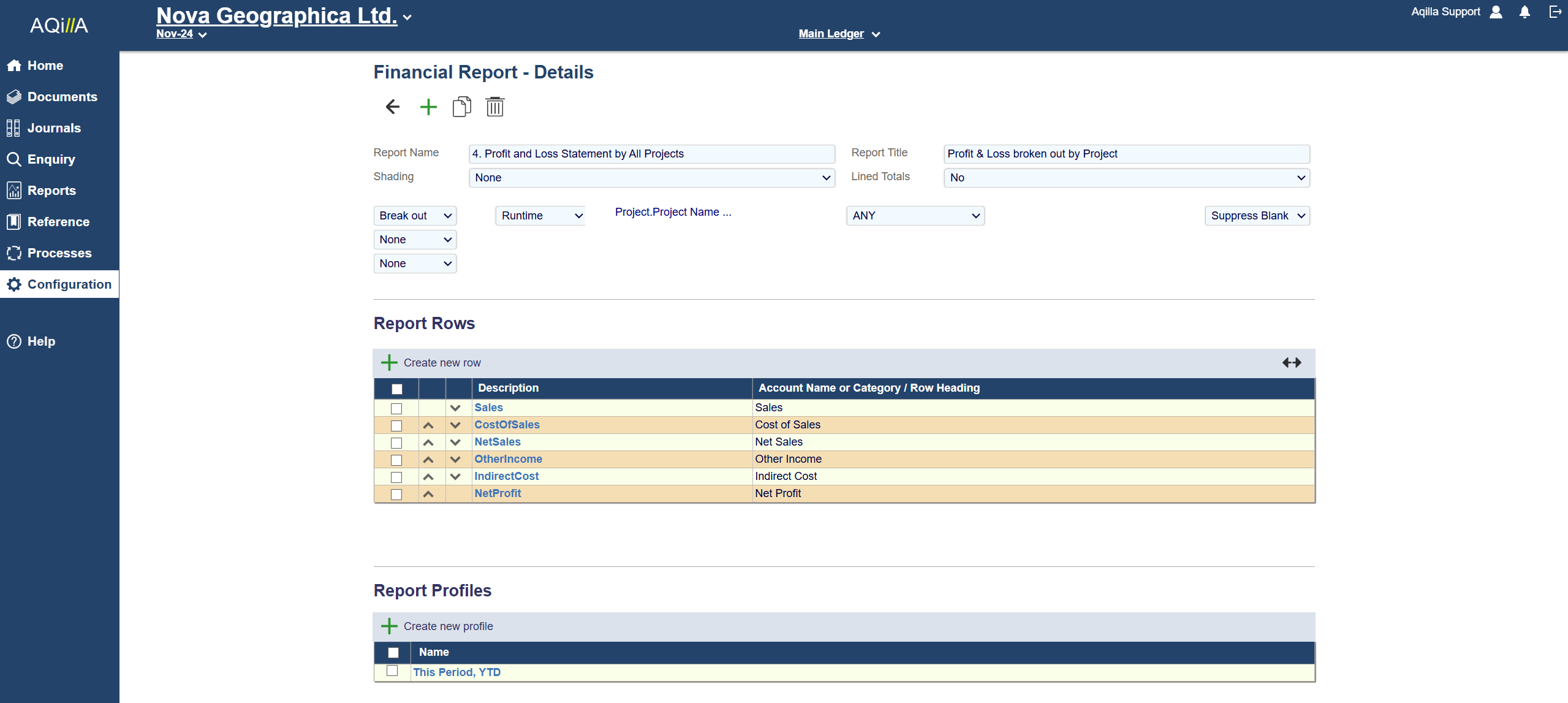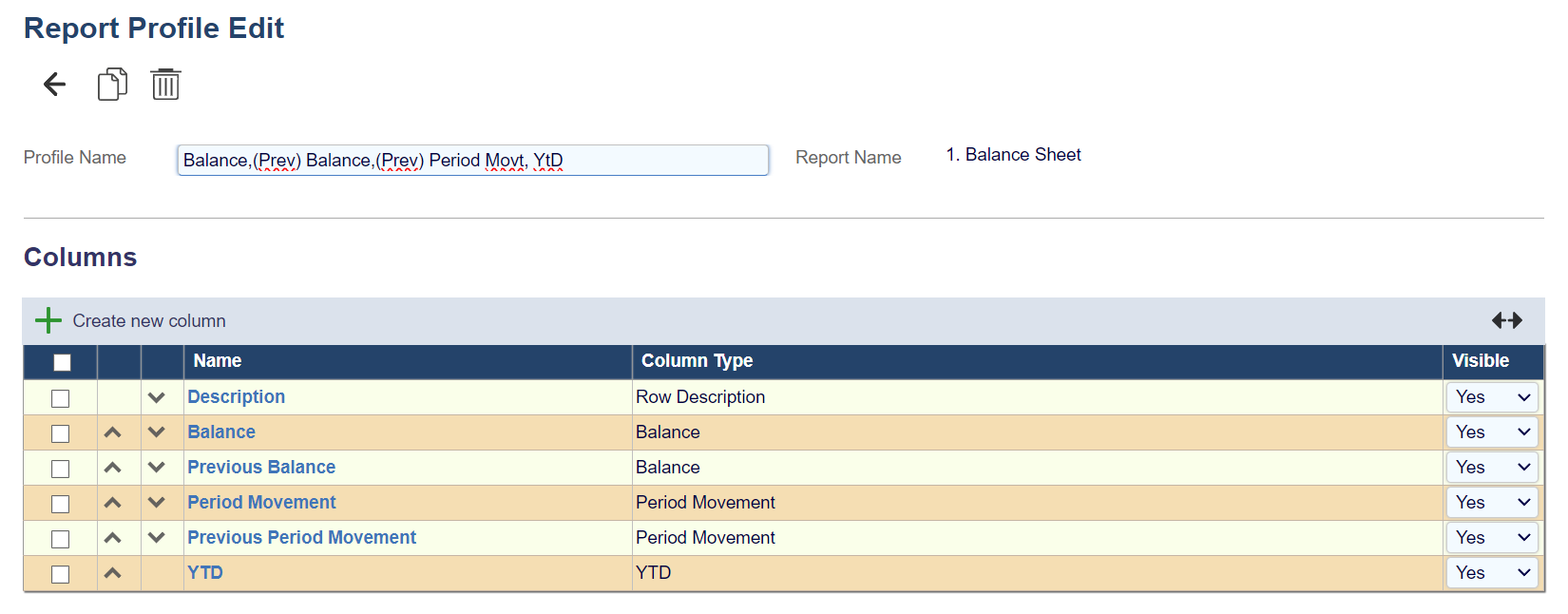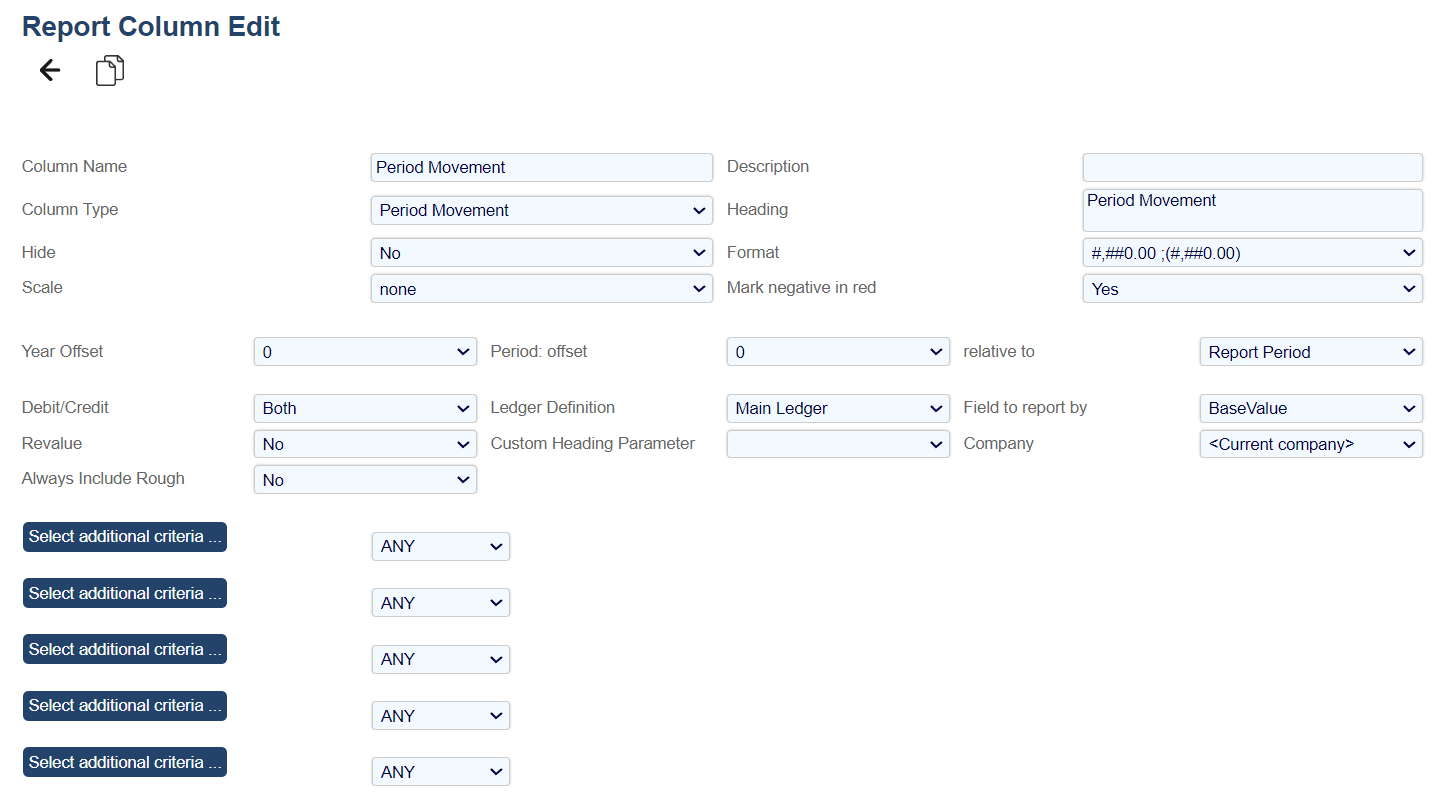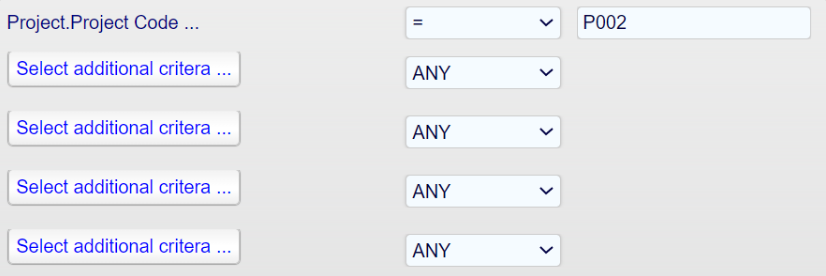Financial Report Layouts
Financial Reports

This function is used to maintain financial report configurations. You can run a financial report as described at Reports > Financial Reports.
A new Aqilla instance comes with the following standard financial reports:
The standard financial reports use the standard set of account categories and accounts.
You can modify a financial report or create one from scratch but it's often better to copy and rename an existing financial report.
A Financial Report Configuration comprises three sections:
Field | Description |
|---|---|
Basic details about the report and attributes that apply across the report. | |
Details about the rows in the report. | |
Details about the profiles (i.e. groups of columns) in the report. |

Custom Reports
You can customize a financial report to suit your needs.
The following screenshot is showing three custom reports that show P&L by a single project, P&L by all projects and budget and actuals for Projects.

Report Headers, Rows and Profiles
Each report has a Header, Report rows and report profiles.

Report Headers
The Header consist of all filters. The function of the report is dictated by the filters in the header.
Example: P&L by all projects is shown here below.

Each field on this record is described below. Mandatory fields are highlighted thus.
Field | Description |
|---|---|
Report Name | The report name - max 60 alphanumeric characters. |
Report Title | The report title. |
Shading | None or one of several colours - used to emphasise alternate rows. |
Lined Totals | Yes or No - used to emphasise totals. |
You can select one breakout per report and / or up to three filters. Each of these can be either Runtime or Fixed .
If Runtime is selected the user will be prompted to make choices when running the report (e.g. select from a list of projects) and any pre-selected data will be presented as the default. If Fixed is selected the user will not be able to make any changes (e.g. the report is specific to a pre-selected project).
Report Rows:
This function is used to configure the data that shows on the individual rows of a report. Sample report rows are shown below:
A sample Report Row Edit the view is shown below:


Each field on this record is described below. Fields which are mandatory (when displayed) are highlighted thus.
Note that some fields are displayed or hidden based on the Row Type selection as shown below:
Common Fields
Field | Description |
|---|---|
Row Type | One of several predefined types:
|
Description | A description - max 60 alphanumeric characters - not shown on report. |
Row Name | The row name - max 60 alphanumeric characters - must start with an alpha character and contain no spaces. |
Row Sequence | Automatically generated; cannot be edited in this view. |
Heading
The Heading row type uses the above common fields plus the optional field Heading (max 60 alphanumeric characters).
Account Category
Field | Description |
|---|---|
Account Category | An account category maintained at Configuration > Account Categories. This is used as a heading so is not entered separately. |
Suppress Zero Values | Yes or No - if no transactions are selected for an account, the line is suppressed. For instance, if listing all the creditors, it will determine whether a line is displayed for each creditor account or just those with transactions. |
Continuation | A number of rows can be grouped together so that they appear on the report within the same section. If specified this field defines the row name for which this definition is a continuation. |
Continuation Level | 0, 1, 2, 3, 4 or 5 - defines the row number within the grouped row. |
Expansion Level | 0, 1, 2, 3, 4 or 5 - defines what the default level of expansion is in the hierarchy for the given row. Level 0 will show just a single row of totals, greater levels will display additional levels of the hierarchy broken out. |
Continuation Child Level | Blank, 0, 1, 2, 3, or 4. |
Sort By | Account Name, Account Code or Alternative Account Name. Defines the sequence of the accounts within the report row. |
Heading | A heading - max 60 alphanumeric characters. |
Calculation
Field | Description |
Heading | A heading - max 60 alphanumeric characters. |
Formula | The formula uses row names and mathematical operators - e.g. Sales - CostOfSales |
Format | The format in which the result is to be displayed is selected from a drop down list. |
Available Row Names | The available row names are listed to assist the entry of the formula. |
Hidden | If a row should be hidden and only used in calculations. |
Criteria
Field | Description |
|---|---|
Continuation | A number of rows can be grouped together so that they appear on the report within the same section. |
Continuation Level | 0, 1, 2, 3, 4 or 5 - defines the row number within the grouped row. |
Expansion Level | 0, 1, 2, 3, 4 or 5 - defines what the default level of expansion is in the hierarchy for the given row. Level 0 will show just a single row of totals, greater levels will display additional levels of the hierarchy broken out. |
Continuation Child Level | Blank, 0, 1, 2, 3, or 4. |
Sort By | Account Name, Account Code or Alternative Account Name |
Normal Sign | Debit or Credit. |
Heading | A heading - max 60 alphanumeric characters. |
More Selections (5) | Up to 5 additional selections can be applied. |
Report Profiles
If you expect to report across multiple companies held within a single Aqilla instance please also refer to Articles > Multi-Company Accounting.
A Report Profile defines which columns to show on a report and the sequence of the columns across the page. A sample report profile is shown below:
A sample Report Profile Edit view is shown below:

A sample Report Profile Edit view is shown above


A sample Report Column Edit page is shown above.
Each field on this record is described below. Fields which are mandatory (when displayed) are highlighted thus.
Note that some fields are displayed or hidden based on the Column Type selection as shown below:
All Column Types
All column types have the following fields:
Field Name | Description |
|---|---|
Column Name | The column name - max 60 alphanumeric characters - must start with an alpha character. |
Description | A description - not displayed on report. |
Column Type | One of several predefined types:
In combination the two Period Spread columns can typically be used to report on the main ledger for all periods up to the period being reported and for the remaining periods, to the end of year, to report on budgets. |
Heading | Up to three lines of heading can be displayed. |
Hide | Yes or No. This is typically used in conjunction with Calculation columns, where you may not want to display the intermediate figures that make up a result. See also Visible in the Columns summary view. This disables the processing of the column if Visible = No and as such the result is not available to any calculation. |
Numeric Column Types
All numeric column types have the following fields in addition to (1) above:
Field Name | Description |
|---|---|
Format | Determines how amounts are formatted - select from dropdown list. |
Scale | None, Thousand or Million. |
Mark Negative In Red | Yes or No - self-explanatory. |
Balance, Period Movement, YTD, Period Spread Backward, Period Spread Forward
These column types have the following fields in addition to (1) and (2) above:
Field Name | Description |
|---|---|
Debit / Credit | Both, Debit or Credit - specifies whether the column should only report on debit or credit transactions (or both). |
Ledger Definition | The report is based on one of the ledgers defined at Configuration > Ledger Definitions. |
Field To Report By | BaseValue, CurrencyValue or Currency or Base Value - specifies whether the column should use base values or currency values. Selecting CurrencyValue or BaseValue will display the base value if the transaction is in base currency otherwise it will display the currency value. This latter option is normally only used in conjunction with Revalue below. Users may also report by any user defined numeric values in the ledger (e.g. attributes Value1, Value2 etc.) as well as base and currency values. For instance, if Time is being passed to the ledger from timesheets, this can be selected in a report column when defining a report. |
Revalue | No or one of the currency rate types maintained at Configuration > Currency Rate Types. You can choose to revalue the Field to Report By based on any currency rate type. For example if you use daily rates for transaction entry, you may want to define an average rate for the period for reporting purposes. Normally this will be the currency value but if a ledger has a base value different to the main ledger it is valid to revalue this. |
Custom Heading Parameter | Blank or Period Name. If Period Name is selected, the Heading text can contain a parameter %1, which is replaced by the column’s Period Name. |
Company | Selecting Current Company will run the report for the currently selected company. If you select a specific company (e.g. to produce a multi-company report) then data for that company will be used when calculating values. |
More Selections (5) | Up to 5 further selection criteria can be applied to the column. For example, this might be used to show separate columns for each division or cost centre or project.  |
Balance, Period Movement, YTD
These column types have the following fields in addition to (1) and (2) and (3) above
Field Name | Description |
|---|---|
Year Offset | 0 or a negative or positive value - used to define the column in a different year relative to the report year. |
Period Offset | 0 or a negative or positive value - used to define the column in a different period defined by the Relative To parameter. |
Relative To | Report Period, Last Period or First Period - specifies whether the period is relative to the period defined when running the report or relative to the beginning or end of year. |
Calculation
Calculation columns have the following fields in addition to (1) and (2) above:
Field Name | Description |
|---|---|
Formula | If the column is a calculation, the calculation is defined here using the available columns that are displayed in the report (and constants). A calculation uses the standard + - * / and ( ) operators. For example to calculate a budget variance percentage, the calculation might be: (Balance – Budget Balance) / Budget Balance * 100 The ABS function is also supported e.g. ABS(Balance – Budget Balance) will always return a positive result. Note that all columns that make up a calculation must be defined in the same report profile. If required, columns can be hidden from the report. |
Available Columns Names | The available column names are listed to assist the entry of the formula. |
Apply Category Sign | Yes or No - The default behaviour when displaying a value in a column is to use the sign defined against an account’s account category at Configuration > Account Categories. This is not always applicable when performing a calculation. This option enables this feature to be disabled for specific columns. |
